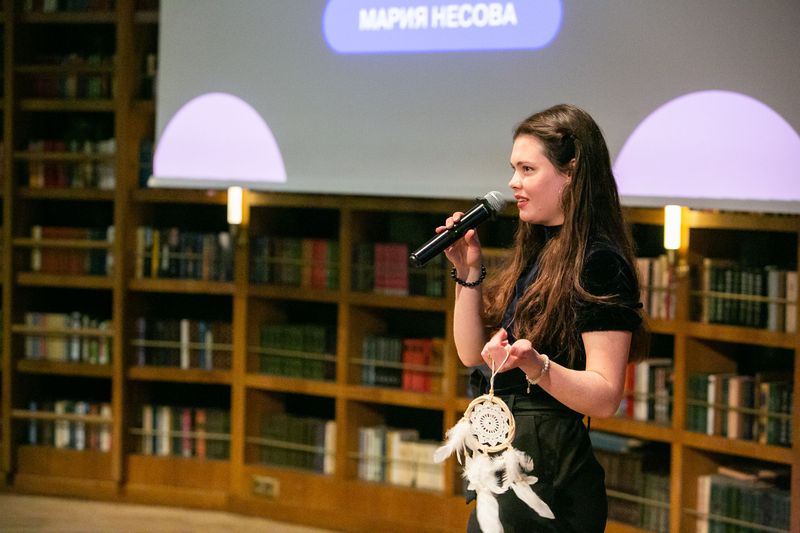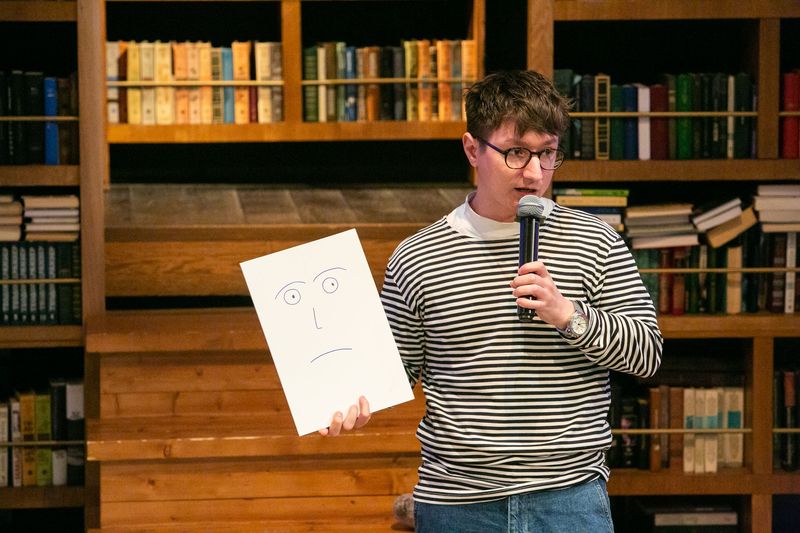From Cultural Appropriation to Prison Jargon: Second Semi-Final of Science Battles Takes Place at HSE University
On March 19, the second semi-final of the fourth season of HSE University Science Battles brought together the topics of cultural appropriation, pharmacological neural networks, prison jargon, and ‘diseases’ of higher education on the same stage. Students from various degree programmes presented their projects in the Community space. Read on to find out more about the performances featured in the semi-finals.
HSE University Science Battles is a traditional platform of HSE University where young scientists talk about their new research in different fields. In 10 minutes, an aspiring researcher has to present the essence of their work and the results obtained in simple and comprehensible language, and answer questions from the audience and the jury.
Following all the performances, the winner is chosen based on an audience vote and the expert jury’s opinion. In this semi-final, the jury consisted of Maxim Shkurnikov, Candidate of Medical Science and Head of the Laboratory for Research on Molecular Mechanisms of Longevity, Ksenia Bondarenko, visiting lecturer at the Faculty of World Economy and International Affairs, Alexandra Nagornaya, member of the Academic Council of the Bachelor’s in Foreign Languages and Intercultural Communication, and Artem Kosmarsky, Senior Research Fellow at the Faculty of Urban and Regional Development.
As a rule, four projects come together in the semi-finals of Science Battles. The winners of the semi-final rounds will then meet in the final to determine the best of the best.
Maria Nesova, first-year student of the Master’s programme in Culture Studies, presented her research on the topic ‘Steal Like an Artist: What Do Russians Think about Borrowing in the Fashion Industry?’ The next Science Battles participant, Daria Kovalenko, fourth-year student of the Bachelor’s Public Administration, spoke about Baumol’s cost disease in higher education.

Pharmaceutical Business
‘Have you ever thought about how medicinal products are developed? How about the fact that Arbidol, a drug known to many, is useless and its popularity is just marketing?’ Anastasia Korzhenevskaya, a third-year student of the Bachelor’s in Chemistry, addressed the audience. Her competition entry was the report ‘Drug Design: How New Drugs Are Created in the Modern World’. As a result of audience and expert voting, her report took second place.
Drug development is a rather time-consuming process in which many chemical aspects have to be taken into account. Personalised medicine has recently started to develop in Russia: doctors have started paying more attention to the specifics of each person’s body, as there is no single drug that solves everyone’s issues.

But today, medications are big business. Medicinal products are made primarily to increase profit: ‘Nobody will invent a medication for one person. Medications are primarily a business and people will be happy to pay you,’ the student points out.
To increase the efficiency of new drug creation, neural networks are used to assist in selecting active proteins and combining substances through a technological process. Some neural networks are already capable of creating medications, selecting the right drugs, and finding the right targets for the molecules. ‘The whole process is already roboticised. It sounds cool, and it seems to have come quite far. It might seem like a fairy tale now, but it’s likely that things will soon become reality, with robots replacing chemists and medics in the future. But fortunately or unfortunately, this is not going to happen any time soon,’ stresses Anastasia.
‘Rat’, ‘Disc Jockey’, and ‘Windbag’
‘A fellow who does not speak the lingo will never be a crony to a kingpin,’ claims Pavel Kivalin, first-year student of the Master’s in Foreign Languages and Intercultural Communication. He conducted a comparative study of prison jargon in America and in Russia and won the jury and audience’s vote.

The work was tremendous: Pavel analysed more than 2,000 jargonisms in English and Russian and found a significant share of metaphors. Words with a figurative meaning are often used by prisoners because they allow information to be conveyed succinctly. Metaphors in jargon also serve the function of ‘camouflaged’ communication, allowing the desired meaning to be conveyed allegorically. ‘It is neither a fad nor an embellishment, but a tool to reduce uncertainty within the prison world,’ notes the researcher.
Interestingly, some metaphors have the same meaning in different countries. For example, ‘rat’ means snitch, ‘disc jockey’ means dishwasher, and ‘windbag’ means chatterbox in the jargon of prisoners both in the US and in Russia.
‘The frequent coincidence of animal metaphors tells us that American and Russian prisoners equally perceive themselves as second-class, less important people. The coincidence of occupational metaphors reveals a common habit of shifting the main features of a profession to humans. And the frequent use of impersonal nouns suggests a general tendency of the prisoner’s psyche to dehumanise those who do not behave according to the rules of the prison world,’ Pavel summarised.
See also:
From Ingenious Fungi to Post-feminism: HSE University Hosts Season’s Last Science Battles Semi-Final
Season VI of Science Battles at HSE University is entering the homestretch. The June semi-final determined the list of finalists and helped many viewers choose their favourites. This time, young researchers decided to figure out how to conduct a police lineup without destroying a person’s life, as well as how to improve a child’s academic performance without instilling neurotic perfectionism. They also found out that fungi and mould help heal scars and save the environment, and that adherents of post-feminism have very mixed feelings about their own images on TikTok.
From Hate-Watching to GMOs: Highlights of the HSE Science Battles’ Third Semi-Finals
The fifth season of HSE Science Battles is currently underway, with the Sber office serving as a venue for another stage of the battle. Four speakers fought for a place in the finals by presenting their research in a ‘TED Talks’ format. The HSE News Service reports on highlights from the event, including how to explain to your grandmother that GMOs aren’t dangerous, what font you should use to develop your memory, and who ‘hate-watchers’ are.
Robot Rights and Talking Babies: Discussions at HSE Science Battles
Four young scientists competed in the second semi-final of the fifth season of HSE University Science Battles, which was held at HSE Cultural Centre. What tasks lead students to cheat on exams, how babies learn to talk, whether artificial intelligence is subject to copyright, how to deal with false modesty — each researcher presented their work while the audience and the jury chose a winner to compete for the main prize of the season — an academic travel grant.
‘It Was Interesting to Showcase a Unique Student Project’
Held as part of the Second New Knowledge Marathon, the fourth HSE Science Battles attracted a wide audience. HSE Students Frol Sapronov, Marina Kasyulina, and Vsevolod Nikolsky took part in the competition’s new televised format to demonstrate how to talk about science vividly and in simple terms understandable to any audience.
HSE Science Battles Wrap Up Third Season
What professions in Russia are considered ‘dirty’? Do computers have empathy? What happens when the brain incorrectly predicts how we feel? The answers to these and other questions were tackled at the final round of the HSE Science Battles, which was held online for the first time this year. Read on to find out which performance was rated highest by the audience and jury and why the Science Battles are a must-see for everyone.


